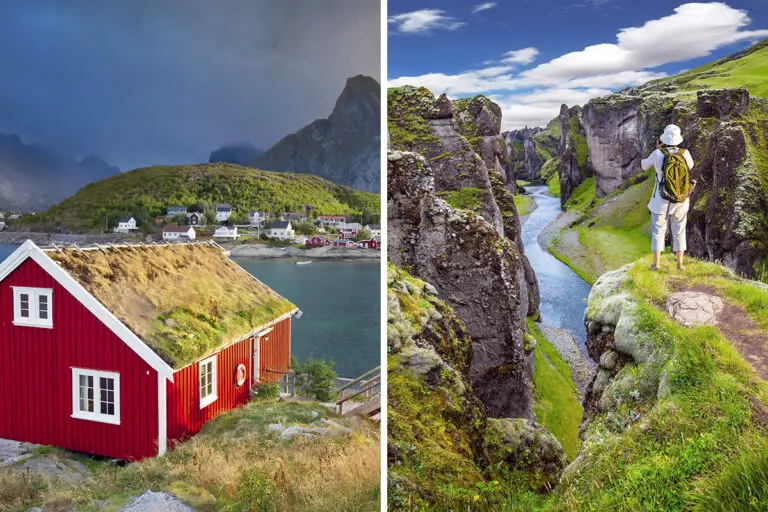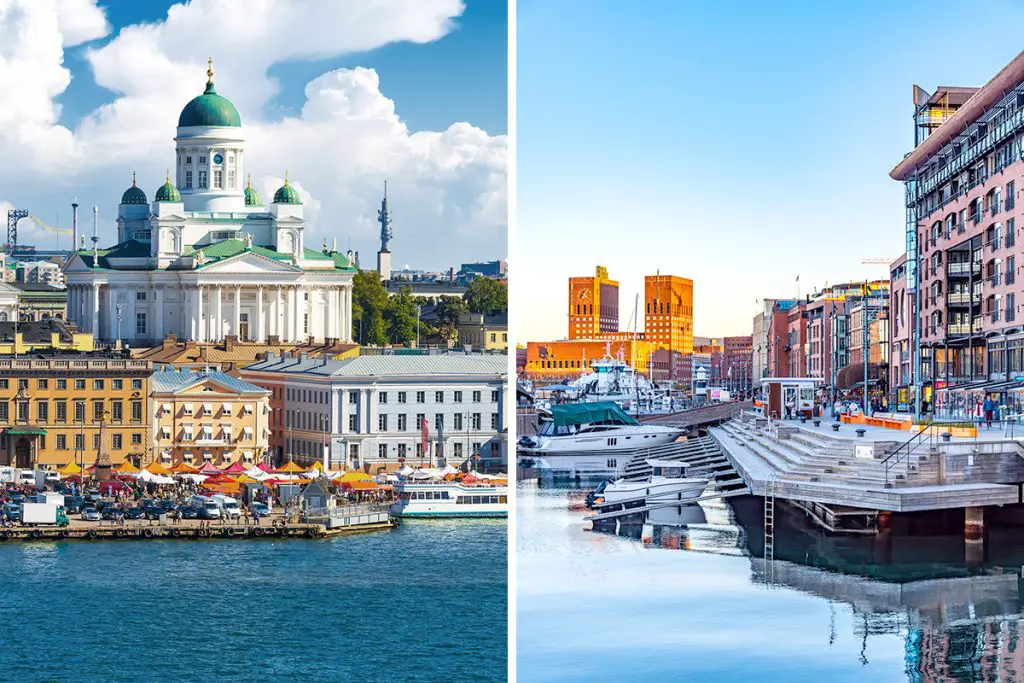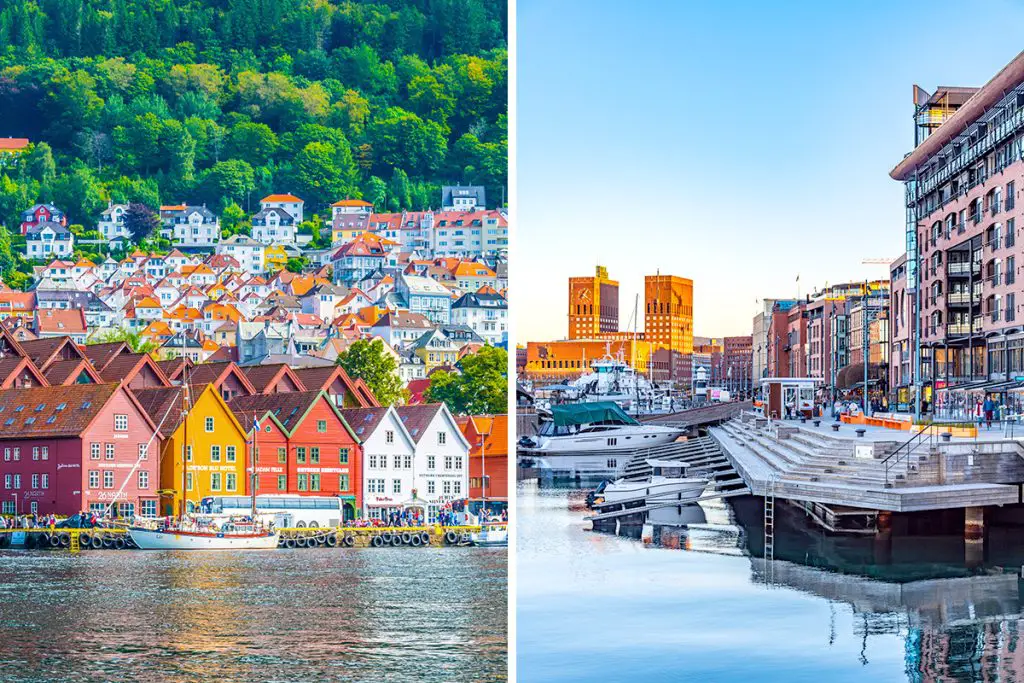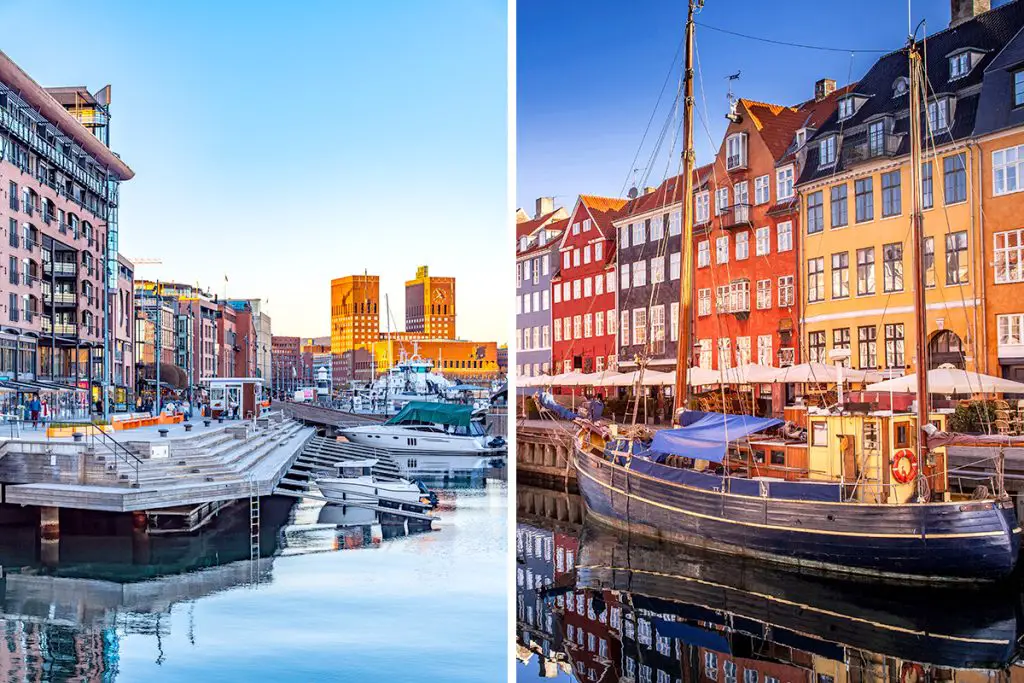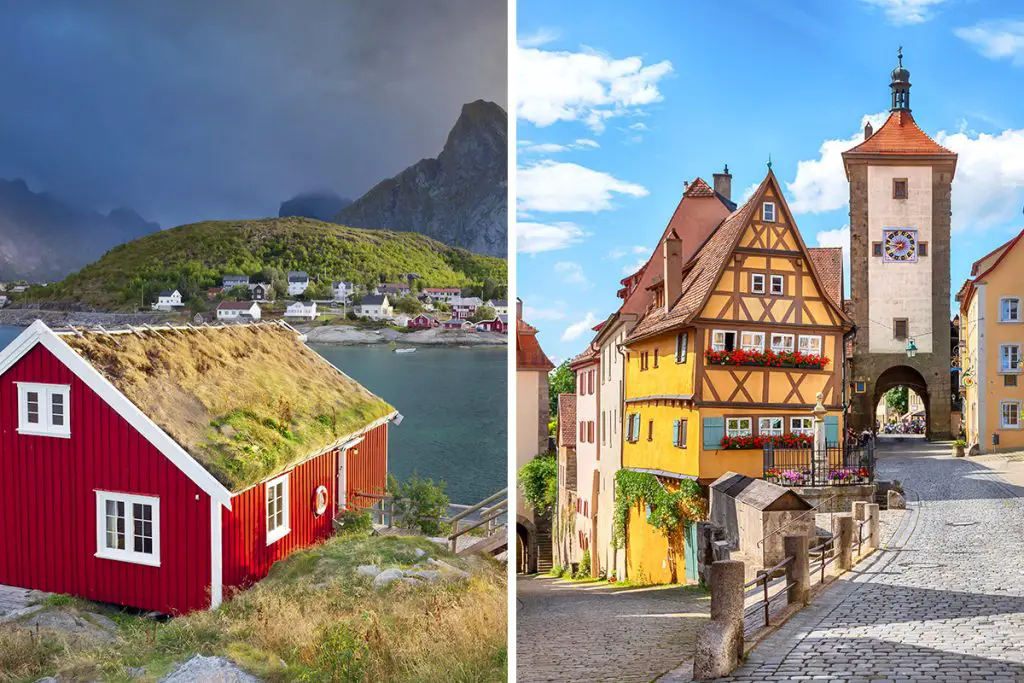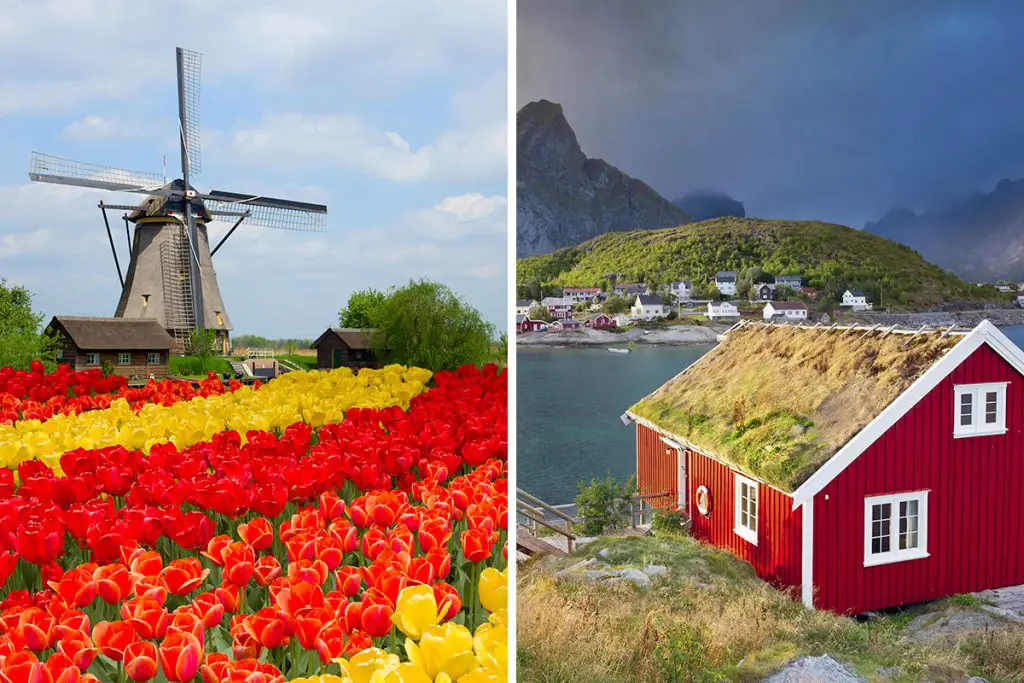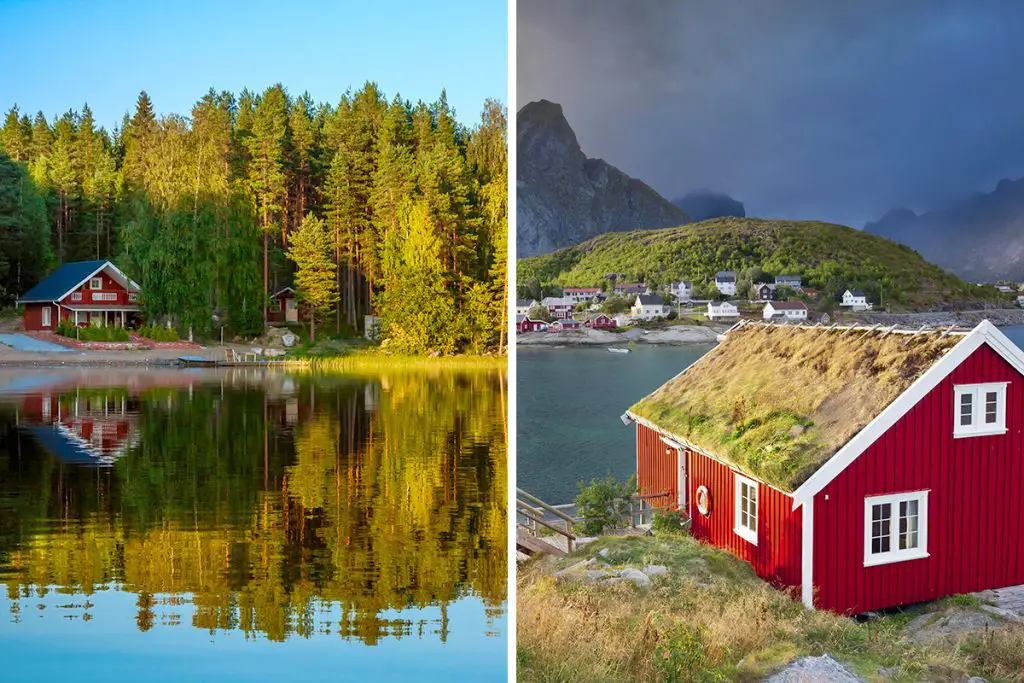Iceland or Norway? This question often comes up when it comes to Nordic destinations.
But an even more popular debate is whether you should visit Norway or Iceland for northern lights. And on that note, both offer a stellar experience. Some might say Iceland is better, but that’s not entirely true.
Based on the solar radiation charts and forecast data, Norway and Iceland aren’t at all different in this regard. However, what’s different is the timing of when to visit, which you’ll learn more about in this guide.
Speaking of differences, here’s a quick overview between the two:
In a nutshell, Norway is more about fjords, mountains, scenic hiking, forests, and national parks. Whereas Iceland features a more rugged terrain but boasts a hotbed of geothermal attractions. Think hot springs, volcanic landscapes, geysers, and even mud pools.
So, what type of vacationer is most suited to Iceland or Norway? You’re about to find out.
Norway
Love the outdoors? Scenic hiking with breathtaking landscape options? How does being able to camp virtually anywhere sound? Is safety a high priority on your vacation?
If you said yes to at least one of those questions, Norway is your best bet.
Norway is beautiful. So beautiful you’ll shed a tear after seeing its fjords. The landscape here is graceful, peaceful, and breathtaking, even when its mountains are blanketed in snow.
A good way to define Norway is through the term friluftsliv. This translates to spending time outdoors and connecting with nature – a trait Norwegians are passionate about. In other words, Norway is a place filled with hiking opportunities and camping expeditions.
However, Norway isn’t all just fjords.
There are coastlines and mountains to explore too. Not to mention, accommodations situated in some of the most scenic places. Imagine staying in a cabin on the side of a lake. Or for nature lovers, in the middle of the woods.
And who could forget that Norway is also home to exceptional seafood, especially salmon. The Norwegian Salmon you buy so often at the supermarket? Well, now’s your chance to try it fresh. In fact, you can even catch your own.
Other amazing facts about Norway? For one, they’re also one of the happiest people on Earth. Second, you won’t have as much trouble asking for help or directions since a lot of Norwegians speak English. Third, for those that love skiing, there are several excellent ski resorts.
Fourth, nearly all of the national parks in Norway are free to enter. Yes – free. As in, no entrance fee whatsoever.
This guide could keep going on top-charting reasons why you should visit Norway. But rather than turn this into a stampede of information, here are the most appealing reasons to visit.
What Makes Norway Unique?
Edge-of-the-World Hiking Experiences
Even for someone who isn’t fond of hiking, Norway’s hiking trails will quickly turn you into a hiking enthusiast.
Hiking in Norway isn’t your average hike-through-the-woods kind of activity. Here, you’re taking long scenic walks on some of the most awe-inspiring landscapes in the world. Sure, some trails are steep. However, the view and natural beauty around easily distract you from thinking about the length of your journey.
Even kids could do it. And that’s a fact. Several of Norway’s hiking trails are beginner-friendly. The trail from Preikestolen Mountain Lodge to Pulpit Rock is by far the easiest. It’s also one of the most popular as people of all ages can hike this trail.
Once you’ve reached the summit of Pulpit Rock, you’ll be begging for more. The grand view that overlooks Lysefjord is only one of the many breathtaking scenes you’ll experience.
For active hikers, take the Kjeragbolten trail. Here, the giant boulder wedged between two cliffs in Kjeragbolten is a must, if you dare.
Up for a challenge? The reward is an edge-of-the-world feeling accompanied by beautiful mountain views. This famous hiking trail in Norway is none other than Senja.
For unbeatable views and an uncontested champion in hiking trails, head to Romsdalsseggen Ridge. This trail is often referred to as the best hiking trail in Norway.
There’s no doubt Norway ranks at the top when it comes to hiking activities. But also, these breathtaking landscapes offer more than just a chance to put in cardio and hit daily step goals.
Because really, Norway’s landscapes offer the chance to connect with nature. It offers tourists to experience a remarkable world preserved in its natural state. And above all, it’s open for all types of travelers to do. So, why pass up on the chance, right?
On that note, here are a few other beautiful hiking trails worth mentioning:
- Trolltunga
- Reinebringen
- Besseggen Ridge
- Ryten and Kvalika Beach
- Matind and Stave-Bleik Coastal Trail
Exceptional Seafood
Although Norway is known for its excellent salmon, it’s certainly not the only dish worth drooling over. You’ll often hear the phrase, “shellfish in Norway is second to none.” And that is 100% true.
Crab, mussels, crayfish, scallops, trout, cod, you name it. One of the best ways to taste some of the freshest catches of the day? Fish markets. Whatever seafood you fancy, you’ll find it here. The Ravnkloa Fishmarket, located in Trondheim, offers one of the best smoked and marinated fish.
Bergen is another fish market that has its fish trading origins rooted as far back as 1276. Easily, Bergen is one of Europe’s finest, albeit expensive. That said, a trip to Bergen is worth it. Wandering along the harbor around the area already makes it a worthwhile experience. Needless to say, being able to try the freshly caught seafood in Bergen at least once is a must.
But if you prefer a more custom-made meal, Stavenger is your best bet. The fish market is a popular choice if you’re after specially made meals using locally sourced ingredients.
Fish markets aside, there are a few oceanic delights to keep your eye out for. Norwegian Skrei and lakserull (smoked salmon roll-ups) are at the top of the list. You cannot leave Norway without trying these amazing dishes.
Of course, king crabs, lobsters, mackerel, and prawns are equally fantastic. For the best mackerel, head to Southern Norway. And for the cream-of-the-crop prawns, specifically Lyngen Reker prawns, visit Lyngenford. Located in Northern Norway, the Lyngenford region is the best place to get first-class prawns.
Finally, don’t miss Norway’s world-class seafood restaurants either. Whether it’s langoustine soup, halibut nigiri, or grilled salmon, put these restaurants on your bucket list:
- Fiskeruta
- The Salmon
- Lofotstua AS
- Restaurant Fjord
- Fiskeriet Youngstorget
The Freedom to Camp Almost Anywhere
Outdoor lovers, you’ll fit right in. Mostly all of Norway is a camp zone. Or in other words, you can pitch a tent just about anywhere that suits your liking. Whether it’s in the wild, near a fjord, or by a lake.
Wouldn’t that be amazing? Being a few steps away from a refreshing dip in a fjord is an amazing and unique experience. And it’s all thanks to Norway’s longstanding law, allemannsretten. The loose translation is “right to roam.” And what it essentially means is being able to set up camp virtually anywhere.
Of course, there are a few rules to note too. For instance, you can camp on uncultivated land for two nights without asking permission from the landowner.
You’re even free to go foraging around the area, be it fresh berries, mushrooms, or herbs. The same goes for activities like fishing and hunting. Although, there are a few limitations around that too. For fishing expeditions, you can fish for saltwater fish so long as you’re using handheld tackle.
In the case of freshwater fishing, you need a permit.
Worried about animal attacks in the wild? You’ll be happy to know there aren’t any dangerous animals stalking your tent at night.
Outdoor Beauty Like No Other
You’ve already read a glimpse of the outdoor life Norway has to offer. With more than 14 hiking trails to choose from, any outdoor lover would be pleased.
But if you thought that was the end of the road for outdoor adventure in Norway, think again. The land of fjords bears its nickname for a reason. Apart from hiking trails, there are fjords, pine forests, lakes, glaciers, and waterfalls. All of which are immaculate sights for anyone.
Want to visit them all? You’d probably need about 3 weeks to a month if you want the full immersive experience. But don’t worry. This isn’t to say you won’t be able to visit the most stunning landscapes while in Norway.
All fjords in Norway are beautiful. And that refers to all 1,100 fjords scattered throughout the country. You can see why it’s called the land of fjords now, right?
Although all fjords are indeed stunning, there are a few that stand out. One of which is Geirangerfjord, also a UNESCO World Heritage Site. Its deep blue waters and towering mountain peaks are only half of Geirangerfjord’s spectacular scenery.
For one of the best fjord scenic rides, add Aurlandsfjord and Nærøyfjord to your bucket list. There’s so much green here that allows you to instantly relax the minute you set foot in the area. But even more breathtaking is the mix of emerald and blue waters that outline the entire coastline.
With trips to fjords making up most of a tourist’s itinerary, don’t forget there are other sights to see too. In fact, some fjords are home to national parks for those interested in wildlife watching and more sightseeing.
You can also hike around these national parks and see brilliant glaciers and graceful mountain landscapes.
Sounds like your travel itinerary? Head to Sognedford, which is home to 2 national parks Jotunheimen and Jostedalsbreen.
From here, don’t miss the 300 waterfalls in the land of fjords. Although many attribute Norway to its fjords, Norway’s waterfalls aren’t lacking at all in appeal. And that goes for its pine forests and lakes too.
Some of the best waterfalls worth visiting in Norway include Vinnufallet, The Seven Sisters, and Låtefossen. If you want more, here are five more to add to your list:
- Vettisfossen
- Mardalsfossen
- Kjosfossen Flåmdalen
- Husedalen Waterfalls
- Vøringsfossen Eidfjord
Iceland
The landscape is where Iceland and Norway differ. While Norway features fjords, mountains, and peaceful scenery, Iceland is a land of both ice and fire. Not literally, of course. But its nickname, Land of Ice and Fire bears some truth.
For starters, Iceland is full of geothermal attractions. Imagine bubbling mud pools, spewing geysers, volcanoes, and natural hot springs.
Second, the Land of Ice and Fire is also famous for its black-sand beaches, glorious waterfalls, and ice caves. Just like in Norway, there are tons of hiking trails here too. But what’s different is the opportunity to bathe in thermal waters after a long day’s hike.
Its most renowned waterfall, Goðafoss, holds the title “Waterfall of the Gods.” The story of Goðafoss dates back to when Norwegians worshipped Old Norse gods like Thor, Odin, Freya, and Loki. The waterfall bears some historical significance. But apart from its history, its jaw-dropping waterfall appeal is perhaps second to none.
Take note, though.
Iceland isn’t just volcanoes, ice caves, and waterfalls. The Land of Ice and Fire is also home to unmissable experiences like the Golden Circle and Blue Lagoon. Just these two places alone already make your trip to Iceland worth it.
To learn more about these experiences, the next sections provide a full picture.
What Makes Iceland Unique?
The Golden Circle Is One of the World’s Most Beautiful Trips
Ask anyone about things to do in Iceland, and you’ll often hear “The Golden Circle.” Only two attractions in the entirety of Iceland can compete with the Golden Circle in terms of popularity and beauty. One of those is the Goðafoss waterfall. Nevertheless, The Golden Circle sits at the top 3 for a reason.
But what exactly is The Golden Circle? In a nutshell, it’s a 190-mile (300 km) route that takes you through Iceland’s three most highly-rated attractions. These attractions are:
- Gullfoss Waterfall
- Thingvellir National Park
- The Geysir Geothermal Area
However, these aren’t the only attractions tourists can do around The Golden Circle. In fact, you can choose from five different Golden Circle itineraries.
For instance, tourists on a budget can do the 10-Hour Golden Circle Tour including a visit to the Langjokull glacier. Also known as the second largest glacier in Iceland, tourists can go snowmobiling across Langjokull.
You can also opt for a more extensive Golden Circle tour, lasting 3 or 4 days at most. These tours allow you to see everything the Golden Circle has to offer. Some tour packages include hiking across glaciers, exploring ice caves, and swimming in the famous Blue Lagoon.
Should you visit Iceland, be sure to add The Golden Circle as part of your itinerary. It’s the easiest and most convenient way to see several of Iceland’s best attractions. Or better yet, you can spend the night in this beautiful terrain surrounded by an awe-inspiring landscape.
For adventurists though, you might be better off exploring The Golden Circle on your own and at your own pace. Especially if the tour comes out to be costly.
Hot Springs to Cool and Relieve You Any Time of the Day
No trip to Iceland is complete without at least bathing in its ever-popular thermal springs. Taking a dip in Iceland’s hot springs is a way of life. A cultural tradition at best. So, if you want to know what it’s like to live as a local in Iceland, be sure to bathe in these rejuvenating waters.
Speaking of which, Iceland’s hot springs are the all-around cure for stress. This includes other benefits like:
- Relieving joint aches
- Improving blood flow
- Boosting your immune system
What’s more, nearly half of the hot water in Iceland’s capital region are geothermal waters. That means finding a hot spring to bathe in is easily accessible.
Now, the main highlight.
What are some of the best hot springs in Iceland? It’s worth noting that the Land of Ice and Fire has natural hot springs, along with several man-made lagoons.
One of those lagoons that didn’t form naturally is Blue Lagoon. That said, don’t discredit it just because it isn’t natural. Although the landscape isn’t natural, the water is. Not to mention, it’s the most popular and famous hot spring in Iceland. Plus, it was named one of the 25 Wonders of the World.
For what it’s worth, the Blue Lagoon is one of Iceland’s best bathing spots. And any tourist would surely enjoy bathing in its geothermal waters.
If you’re after a more natural hot bath, you might want to check out Sky Lagoon. Bathing in this natural geothermal spa is similar to swimming in an infinity pool. Except, you have more add-ons like the natural landscape, lava-rock cliffs, and a view that overlooks the Skerjafjordur bay.
Think of an outdoor sauna with a view that stretches past the horizon. Now, imagine an almond terrain and cliffs made of lava rock surrounding that outdoor sauna. On a cold morning, bathing in the Sky Lagoon is the perfect way to relax and recharge.
Even better, it’s a fantastic spot known to offer spectacular views of the midnight sun and northern lights.
For those eager to combine a day’s hike with a refreshing hot spring bath, visit Reykjadalur Steam Valley. The hike takes about an hour, which isn’t so bad when you have a relaxing hot spring waiting for you at the end.
Adding to the list of the most beautiful hot springs in Iceland is Hveravellir. This hot spring is by far one of the most unique and offers a picture-perfect view from every angle. In addition, you have the option to spend the night in the area.
Unlike most hot springs, Hveravellir is located within one of Iceland’s nature reserves. However, this particular nature reserve is also considered one of the last great wilderness areas in Europe.
Honestly, this list could go on for five more pages. That’s just how vast your hot spring options are in Iceland. To end this section, here are a couple more hot springs worth visiting in Iceland:
- Viti in Askja
- Kerlingarfjöll
- Gamla Laugin
- Laugavallalaug
- GeoSea Sea Baths
A Place for Outdoor Enthusiasts, Solitude Seekers, and Nature Lovers
The Golden Circle and Iceland’s many hot springs already scream adventure. But there are even more adventures to add to your list.
Another bucket list adventure is being able to explore the Þríhnúkagígur magma chamber. You won’t find any place around the world that offers this kind of experience. Mainly because touring Þríhnúkagígur means getting the chance to set foot inside the heart of this dormant volcano. And take note. This is the only magma chamber in the whole world you can set foot in.
From here, make your way to the Jokulsarlon Glacier Lagoon. The highlight of this attraction is being able to see floating icebergs slowly moving toward the ocean. It’s also a great opportunity to unwind and take the time to slow down. For many, they consider it to be one of their most unforgettable Iceland experiences.
Speaking of glaciers, did you know these glaciers form ice caves during the winter? And since ice caves are only available for exploration in the winter, it’s definitely a must if you get the chance. After all, how often do you see an ice cave, right?
Once you’ve done all of that, don’t forget that Iceland is also home to over 200 waterfalls and 130 volcanoes. If you want to add some cultural adventure, visit Iceland’s capital, Reykjavik.
The capital of Iceland has a few historical sites worth visiting. But overall, it’s the overall charm and colorful vibes here that truly make it worth visiting.
Black-Sand Beaches
When you think about Land of Ice and Fire, it’s fairly obvious that volcanoes and glaciers play a role. But there is one more attraction to Iceland you won’t hear about as often: black-sand beaches.
These beaches are made of volcanic sand. Although lava is indeed orange-red, it’s a different story once the lava has cooled down. With so many volcanoes around Iceland, spotting a black-sand beach is pretty easy.
And the most famous and commonly visited is Reynisfjara. Why? For two reasons. First, Reynisfjara is close to Iceland’s most volatile and largest volcano, Katla. And second, this black beach happens to be the warmest place in Iceland. Don’t forget to pop in on this black beach as it’s also a beautiful spot to take a stroll in.
Another stunning black beach with a beautiful landscape is Stokksnes. Its rugged landscape is all part of its charm. Being in Stokksnes feels like entering a fantasy world you’d ever only see in video games.
From here, feel free to explore three of Iceland’s breathtaking black beaches, such as:
- Diamond Beach
- Djúpalónssandur
- Solheimasandur Beach
Norway vs. Iceland – Which Is Better?
From the get-go, Norway has a greener landscape. It’s not a question of which destination is better for outdoor enthusiasts since both offer a wealth of adventures and experiences.
However, Iceland has more sights to see and a wider variety of landscapes. You can hop from a national park to a volcano to a hot spring or lagoon and finally to ice caves, waterfalls, or black-sand beaches. Plus, the Þríhnúkagígur magma chamber is an otherworldly experience you won’t find elsewhere.
All in all, Iceland might be more suited for vacationers seeking adventure the whole trip. If you prefer volcanoes over fjords, Iceland is your best bet.
On the other hand, Norway boasts a massive network of fjords, mountains, and forests. For hiking enthusiasts, Norway is your best bet without a doubt. If you love to camp outdoors, Norway also takes the lead seeing as how you can camp nearly anywhere.
While Iceland’s terrain is naturally more rugged and suited to explorers, Norway’s is more peaceful and graceful. Safe to say, Norway gives you a sense of peace that Iceland doesn’t. Whether it’s a scenic hike to Pulpit Rock, unwinding via a ferry along Geirangerfjord, or camping in the wild.
Another way of putting it is that Iceland may also be better for those who enjoy more adventure. Hence the reason why it’s well suited to those who love to explore. Whereas in Norway, you’re getting more scenic beauty. There are still plenty of sights and attractions to explore. But above all, Norway is also a fantastic choice for recharging and slowing down.
FAQ
Is Iceland or Norway More Beautiful?
Both Iceland and Norway are beautiful, so it depends on what your definition of beautiful is. Norway’s beauty is more of a natural green landscape. Imagine lush forests, mountains that mimic your desktop wallpaper, and fjords at the peak of their natural beauty.
Some might say Norway’s beauty is more of a typical kind of beautiful. Imagine a mountainous and green landscape similar to what you see in brochures, magazines, wallpapers, etc.
Iceland’s beauty isn’t the kind of beauty you see every day. Imagine volcanoes, spewing geysers, and rugged terrain on one side. And on the other, you have massive glaciers, ice caves, lagoons, and black-sand beaches.
So, which destination stands out? If you’re more into forests, nature, and earthy landscapes, Norway is more beautiful. But if prefer a mix of green landscapes with rugged terrains and volcanic geography, Iceland is for you. It’s safe to say that Iceland is truly the Land of Ice and Fire.
Regardless of which you choose, both are beautiful. There’s no denying visiting Iceland and Norway should be a part of your bucket list vacations.
Is Norway Cheaper or More Expensive Than Iceland?
According to several travel budget sites, Iceland is more expensive than Norway by about 9%. However, in recent years, costs have changed. And at the time of writing, Norway is now more expensive than Iceland. That is when you include the cost of living factors, such as transport, rent, groceries, eating out, and so on.
It’s worth noting that Norway and Iceland are two of the most expensive places in the world.
Over the years, the data has also fluctuated. In 2020 for example, Iceland was deemed to be more expensive than Norway. Regardless of what the data shows, it’s important to note that both are costly vacations but at the same time are worth visiting at least once.
According to Numbeo, rent prices are higher in Iceland than in Norway though. But also, grocery prices in Iceland are slightly lower – about 4% – than in Norway. When it comes to meals and eating out, Norway is about 1% more expensive, according to consumer data.
Best Time to Visit Norway and Iceland
One of the best times to visit Iceland coincides with its peak season, between June and August. July and August will have the warmest weather, and June will have 24 hours of daylight. Now, if you prefer to visit Iceland without the crowds, the shoulder months of May and September are the best time.
Traveling to Iceland in either May or September is best for those that want a quieter holiday. Plus, September is also perfect if you want to enjoy the hot springs at their best. Additionally, the first half of October is an excellent time too.
Lastly, if you’d rather spend your vacation in Iceland enjoying all its festivities, visit in December.
As for Norway, June to August is also the best time to visit if you’re after outdoor activities. Since these months are the warmest in Norway, it’s also the best time to go hiking and explore the country.
However, the biggest downside to visiting Norway from June to August is that it typically sees more crowds. If you’d rather visit when there are fewer crowds, May, mid-June, mid-August, and September are your best options.
Plus, these are ideal months to explore all of Norway’s fjords. Visiting Norway from March to May is also a good time. March will have the maximum amount of daylight hours. While in April and May, this is also spring season. So, for nature lovers, this might be ideal for you to see all the flowers and plants blossoming.
Finally, September to March is the best time to see the northern lights in both Norway and Iceland. Just beware of the cold weather, which usually starts in November.
Norway or Iceland for Northern Lights?
Both Norway and Iceland are fantastic destinations for seeing the northern lights. However, Iceland sees less cloud coverage in general. This means you’re more likely to get a cloudless sky in Iceland, allowing you to see the full breadth of the northern lights.
But in general, neither destination is better than the other for seeing the northern lights. It’s important to remember that several factors do play a role.
For instance, there has to be enough solar radiation and the weather itself should be clear. If you’ve been told that colder means higher chances of seeing the northern lights, that’s not true…
One of the biggest factors in seeing the northern lights is a dark sky. This is why many recommend visiting either Norway or Iceland between September and March. Mainly because the nights are longer, offering tourists more chances to catch the aurora phenomenon.
In Iceland, one of the most popular spots for seeing the northern lights is Reykjavík. This is also a convenient location since it’s close to the airport. However, Thingvellir National Park in Iceland is by far the best location to catch the northern lights.
In Norway, the best places to see the northern lights are in Tromsø, Svalbard, and Alta. Some say you have a higher chance of seeing a better display at Svalbard. However, Tromsø remains the popular choice for many because of its convenient location. Plus, many choose to stay in the hotels in Tromsø so that it’s easier to catch the northern lights.
Iceland Fjords vs. Norway Fjords
Although Iceland does have fjords, it doesn’t compare to what Norway offers. There’s no doubt Iceland’s landscape is diverse and beautiful. However, its fjords don’t quite make up the highlight of your trip.
Norway is sometimes referred to as the king of the fjords, and for good reason. You’ll find the most beautiful fjords in Norway. Another way of saying it is, there’s a fjord for everyone in Norway.
Take Lysefjord as an example.
This fjord is popular among hiking enthusiasts and mountaineers. Apart from its breathtaking scenery, it’s one of the best hiking spots in Norway as well.
There’s also Geirangerfjord, which is one of Norway’s most visited fjords. Why? Because it’s the same fjord shown in the movie “Frozen.”
Aurlandsfjord is also yet again one fjord you might have seen often online, especially on Instagram. And it’s not hard to see why. Aurlandsfjord has a charm and picturesque beauty you simply can’t resist not capturing a photo of.
You’ll find countless photos of Aurlandsfjord online. And not just in social media channels. Dozens of travel sites even use it as a headline photo.
All in all, Norway’s fjords offer a phenomenal and striking scenery that’s hard even for Iceland to beat.
Are Norway and Iceland in the EU?
Norway and Iceland are not in the EU. Rather, both countries are part of the EEA or European Economic Area. Being part of the EEA allows Norway and Iceland to be part of the European Union’s single market.
Is Iceland in Norway?
Although both are part of Northern Europe, Iceland is not located in Norway. Iceland is located between the Faroe Islands, Greenland, and Norway. However, this does not mean Iceland is in Norway. On the map, you can easily identify that Iceland is a separate country from Norway.
Is Iceland Close to Norway?
Iceland is close to Norway, with a total distance of 914.7 miles (1,472 km).
How Far Is Norway From Iceland?
From Iceland, Norway isn’t too far. If you take a plane, for example, it only takes less than 2 hours of travel time.
Is Iceland Owned by Norway?
Iceland used to be a part of Norway and is currently a fully independent country. For a time, Iceland was part of the Kalmar Union, then Denmark, and was established as a sovereign state in 1918. In 1944, Iceland was declared fully independent.
Iceland–Norway Relationship
Relations between Iceland and Norway date as far back as 870. Back then, Iceland was an uninhabited island until it was claimed by Norsemen who settled in 870. Initially, Iceland started out as a free state, but in the years 1262 to 1264, it became a Norwegian province.
In 1380, Norway and Denmark were united and ruled by one king. This also brought Iceland to become under Danish rule. In other words, Denmark and Iceland were united under one monarchy.
It wasn’t until the 19th century that Iceland experienced major changes. First, it became a sovereign state on December 1, 1918. And on June 17, 1944, Iceland became an independent republic.
This proves that Iceland and Norway do have a strong relationship. And one where Iceland used to be a dependency of Norway. One could easily say that the relationship between Iceland and Norway is similar to long-lost cousins.
Both also have foreign relations. For example, Norway has an embassy in the capital of Iceland, Reykjavik. Similarly, Iceland also has an embassy in Norway’s capital, Oslo.
Norway and Iceland have also shown a relationship with regard to the following:
- Defense
- Foreign policies
- Economic assistance
Iceland vs. Norway Flag
Both the Iceland and Norway flag are known as Scandinavian cross flags. The flags are symbols of the Nordic region, along with the flags of Sweden, Denmark, and Finland.
You can easily recognize the difference between the Iceland and Norway flag: color. Norway has a red flag with a blue and white cross, while Iceland has a blue flag with a red and white cross.
The colors on each flag represent the country’s most important elements. In the case of Iceland, red symbolizes fire – the island’s volcanoes. White represents the ice and snow that covers Iceland. And blue for its mountains.
For Norway, the tricolors red, white, and blue represent Norway’s independence. Back then, Norway was a part of Denmark, and later became a part of Sweden. It was only when Norway gained independence that it became the flag it is known as today.
The red color symbolizes Norway’s relationship with Denmark and the blue for its association with Sweden.
The differences between Norway’s flag and Iceland’s flag mostly tie back to its historical roots and origins.
How to Get From Iceland to Norway
You don’t have a lot of options to get from Iceland to Norway. The best way is via plane. However, taking a ferry is an alternative option but with a longer route and travel time. Not to mention, you can only take the ferry from Denmark via the Smyril line.
Apart from taking the ferry, your next best option is via a cruise ship. There are cruises that include Norway and Iceland as part of the stops. But all in all, traveling from Iceland to Norway via plane is the best route to take.
The average flight time from Iceland to Norway is about 2 hours and 40 minutes. Sometimes, the flights will include one stop along the way, resulting in a total flight time of 5 or 6 hours.
Iceland to Norway by Ferry
There is no direct ferry service from Iceland to Norway. Most of the regular ferry routes operate from Denmark, Sweden, Germany, and the Netherlands. However, there is one ferry that cruises the North Atlantic and includes Iceland and the Faroe Islands as part of its stops. The ferry, Norröna, operates via the Smyril line.
That said, if you’re coming from Norway, it may be possible to take the ferry. First, you’ll have to take the ferry from Norway to Hirtshals, Denmark. From there, you’ll have to take another ferry to Iceland.
Norway to Iceland Ferry Price
Taking the Smyril line from Norway to Iceland is an expensive option. Even more expensive than booking a flight between both destinations.
The lowest price for an adult is around 5,924.97 Norwegian Krone or NOK (USD 598.6 at 9.90 NOK a dollar). Taking the cruise is an alternative option but is similar in price and sometimes even more expensive.
Norway to Iceland Ferry Time
The ferry time from Norway to Iceland depends on which port you’re departing from. But on average, the estimated ferry travel time is three or four days. In most cases, this also includes a stop in the Faroe Islands, which is an island between Norway and Iceland.
Norway to Iceland by Boat
There are no boats you can take from Norway to Iceland. And even if you charted a private boat, it would be difficult to navigate through the North Atlantic as well.
Norway to Iceland by Viking Boat
There are no Viking boats from Norway to Iceland.
How Far Is Iceland From Norway by Boat?
The distance from Iceland to Norway via boat depends on which port you’re getting off at. From Iceland to Oslo, Norway, the total distance is 1,405 nautical miles (2,602 km). But if you’re departing from Iceland to Bergen in Norway, the total distance is 939 nautical miles (1,739 km).
Iceland to Norway Train
There are no trains from Iceland to Norway and vice versa. The reason is that Iceland is an island in the middle of the North Atlantic. This means there are no roads or tracks suitable for any car or train to pass through.
Although ferries are considered an option, it’s not the most recommended. For the best convenience and lowest costs, you can get from Iceland to Norway via plane.

